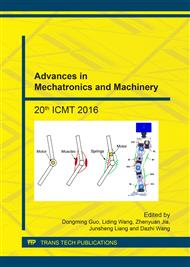[1]
N. Cherradi, A. Kawasaki, M. Gasik, Worldwide trends in functional gradient materials research and development, J. Sci. Composites Engineering. 4(8) (1994) 883-894.
DOI: 10.1016/s0961-9526(09)80012-9
Google Scholar
[2]
E. Autissier, M. Richou, F. Bernard, et al, Design optimization of plasma facing component with functional gradient material Cu/W interlayer, J. Sci. Fusion Engineering And Design. 88(9–10) (2013)1714-1717.
DOI: 10.1016/j.fusengdes.2013.04.042
Google Scholar
[3]
P. Sebastián, E. Vallés, E. Gómez, Copper electrodeposition in a deep eutectic solvent. First stages analysis considering Cu(I) stabilization in chloride media, J. Sci. Electrochimica Acta. 123(5) (2014)285-295.
DOI: 10.1016/j.electacta.2014.01.062
Google Scholar
[4]
J.M. Park, K. Jin, B. Han, et al, Atomic layer deposition of copper nitride film and its application to copper seed layer for electrodeposition, J. Sci. Thin Solid Films. 556(5) (2014) 434-439.
DOI: 10.1016/j.tsf.2014.01.034
Google Scholar
[5]
M. Eslami, H. Saghafian, F. Golestani-fard, et al, Effect of electrodeposition conditions on the properties of Cu–Si3N4 composite coatings, J. Sci. Applied Surface Science. 300(5) (2014)129-140.
DOI: 10.1016/j.apsusc.2014.02.021
Google Scholar
[6]
Z. Y. Yu, T. Masuzawa, M. Fujino, Micro-EDM for three-dimensional cavities – development of uniform wear method. Annals of the CIRP, 47(1) (1998)169-172.
DOI: 10.1016/s0007-8506(07)62810-8
Google Scholar
[7]
W. Chen, X. M. Kang, L. Gu, et al, Research on electrically conductive CVD diamond as electrodes in micro and fine EDM, J. Machinery, 33(4) (2006) 26-28.
Google Scholar
[8]
D. M. Guo, M. Zhang, Z. J. Jin, Particle strengthening of the surface of copper electrode for electrical discharge machining. in: International Conference on Surface Finishing Technology and Surface Engineering Dailan, CHINA: FRONTIERS DESIGN MANUFACTURING (2006).
Google Scholar
[9]
Y.G. Wang. F. L. Zhao, J. Wang., Wear-resist Electrodes for Micro-EDM, J. Sci. Chinese Journal of Aeronautics. 22(3) (2009) 339-342.
DOI: 10.1016/s1000-9361(08)60108-9
Google Scholar
[10]
F. F. Xia, M. H. Wu, F. Wang, et al, Nanocomposite Ni–TiN coatings prepared by ultrasonic electrodeposition, J. Sci. Current Applied Physics. 9(1) (2009) 44-47.
DOI: 10.1016/j.cap.2007.11.014
Google Scholar
[11]
X. P. Li, Y.G. Wang, F. L. Zhao, et al , Influence of high frequency pulse on electrode wear in micro-EDM, J. Defence Technology. 10(3) (2014) 316-320.
DOI: 10.1016/j.dt.2014.07.007
Google Scholar


